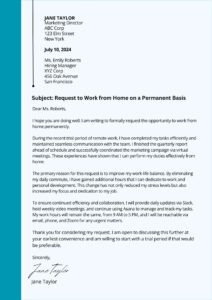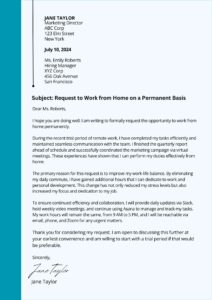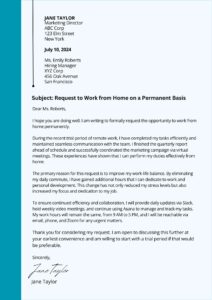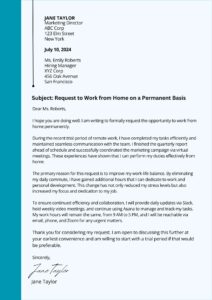Utilizing a standardized format offers several advantages. It helps employees articulate their needs effectively and equips employers with the necessary details to assess requests fairly and consistently. This can lead to improved communication, quicker decision-making, and a smoother transition to permanent remote work, ultimately benefiting both the individual and the organization. A well-crafted structure can also ensure legal compliance and protect the interests of all parties involved.
The following sections will delve deeper into the key components of these structured requests, offering practical guidance for both crafting and evaluating them. Topics covered will include best practices for outlining work arrangements, demonstrating productivity while working remotely, and addressing potential concerns about communication and collaboration.
Key Components of a Permanent Remote Work Request
Effective requests for permanent remote work arrangements typically incorporate several key components to ensure clarity and facilitate a thorough evaluation. These elements provide a framework for presenting a well-reasoned and comprehensive proposal.
1. Rationale for Request: A clear explanation of the reasons for seeking permanent remote work is crucial. This might include improved work-life balance, increased productivity, reduced commute time, or other relevant factors. Supporting evidence or data can strengthen this rationale.
2. Proposed Work Schedule: A detailed outline of the intended work schedule, including start and end times, availability for meetings, and core working hours, demonstrates commitment and professionalism. Flexibility can be addressed while ensuring alignment with team and organizational needs.
3. Home Workspace Setup: Describing the designated workspace at home, including internet connectivity, ergonomic considerations, and a dedicated work area, assures employers of a productive and professional environment.
4. Communication and Collaboration Plan: Addressing how communication and collaboration will be maintained with colleagues and supervisors is essential. This may involve outlining preferred communication methods, availability for virtual meetings, and strategies for staying connected with the team.
5. Equipment and Resource Needs: Clearly outlining any necessary equipment or resources required for successful remote work, such as hardware, software, or other tools, allows employers to plan and budget accordingly.
6. Performance Metrics and Goals: Proactively addressing how performance will be measured and tracked while working remotely demonstrates a commitment to maintaining productivity and achieving objectives. This can include specific metrics, targets, and reporting mechanisms.
7. Contingency Plans: Including a plan for unforeseen circumstances, such as internet outages or equipment malfunctions, demonstrates preparedness and problem-solving skills. This reinforces the commitment to maintaining workflow continuity.
A comprehensive request addresses these elements, demonstrating a well-considered approach to remote work and providing employers with the necessary information for informed decision-making. This structured approach fosters a transparent and efficient process, benefiting both the individual and the organization.
How to Create a Permanent Remote Work Request Template
Creating a standardized template for permanent remote work requests ensures consistency and professionalism within an organization. The following steps outline the key components to include:
1. Header: Begin with a clear header identifying the document as a “Permanent Remote Work Request.” Include fields for the employee’s name, department, and date of submission.
2. Request Summary: Provide a concise statement outlining the desire to transition to a permanent remote work arrangement. Briefly mention the primary reasons for the request.
3. Rationale and Benefits: Expand on the reasons for the request, highlighting potential benefits to both the employee and the organization, such as increased productivity, improved work-life balance, and reduced overhead costs.
4. Proposed Work Schedule: Clearly define the proposed work schedule, including start and end times, core working hours, and availability for meetings. Address flexibility while ensuring alignment with team requirements.
5. Home Workspace Description: Detail the home workspace setup, including internet connectivity, ergonomic considerations, dedicated work area, and any relevant equipment already in place. Assure a professional and productive environment.
6. Communication and Collaboration Plan: Outline a clear communication strategy, specifying preferred communication methods, availability for virtual meetings, and proactive measures for maintaining team cohesion.
7. Equipment and Resource Needs: List any required equipment, software, or resources necessary for successful remote work. Specify whether these resources are already available or require provision by the organization.
8. Performance Measurement: Proactively address performance tracking and measurement. Propose specific metrics, targets, and reporting mechanisms aligned with existing performance standards.
9. Contingency Planning: Outline plans for addressing potential challenges, such as internet outages or equipment malfunctions. Demonstrate preparedness for unforeseen circumstances to ensure workflow continuity.
10. Signatures: Include space for both employee and supervisor signatures, acknowledging agreement and understanding of the terms outlined within the request.
A comprehensive template incorporating these elements facilitates clear communication, streamlines the request process, and provides a framework for consistent evaluation of permanent remote work arrangements.
Standardized structures for requesting permanent remote work arrangements provide a crucial framework for clear communication and efficient decision-making. They ensure consistent conveyance of essential information, including the rationale behind requests, proposed work schedules, home workspace setups, and plans for maintaining communication and productivity. This structured approach benefits both employees, by facilitating well-articulated proposals, and employers, by enabling objective and consistent evaluations. Ultimately, the utilization of such structures contributes to a more streamlined and effective transition to permanent remote work, fostering a mutually beneficial arrangement for all stakeholders.
As the landscape of work continues to evolve, the adoption of formalized processes for remote work requests will become increasingly critical. Organizations that embrace these structures will be better equipped to navigate the changing dynamics of the modern workplace, attract and retain top talent, and foster a productive and engaged workforce. Careful consideration of the elements outlined within these requests, and a commitment to clear communication, will pave the way for a successful and sustainable future of remote work.



